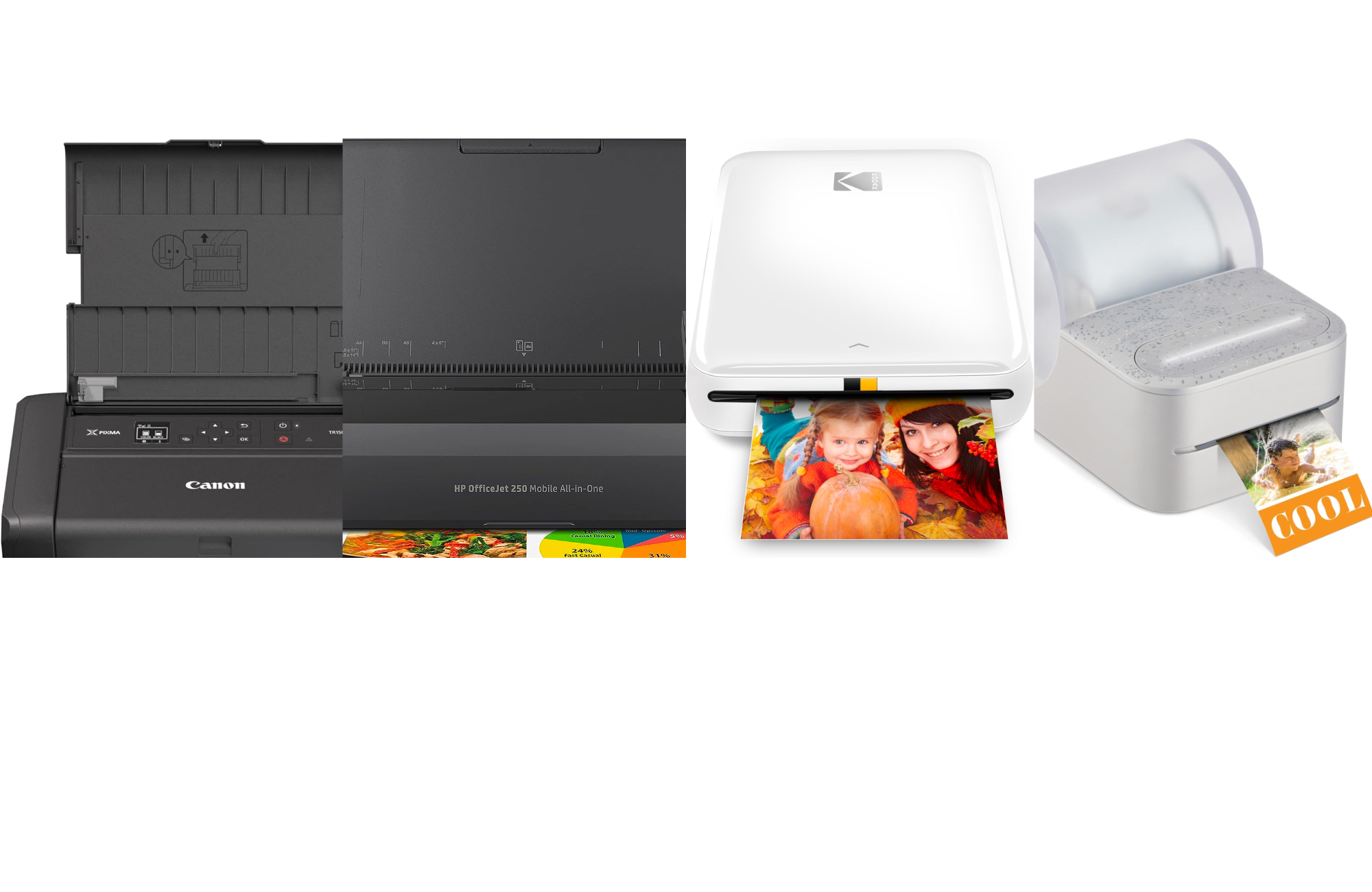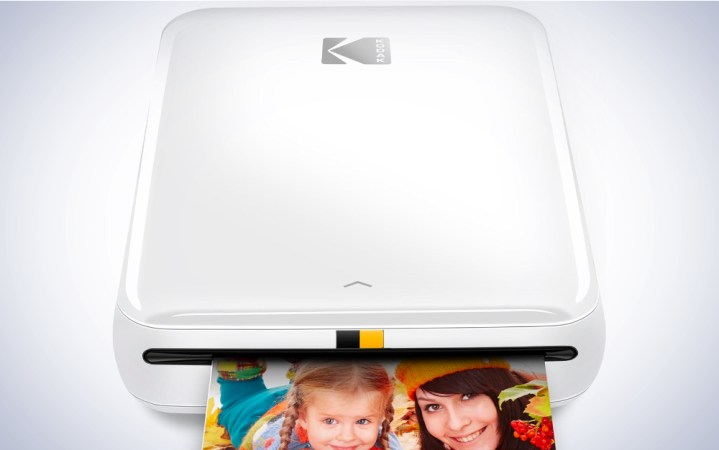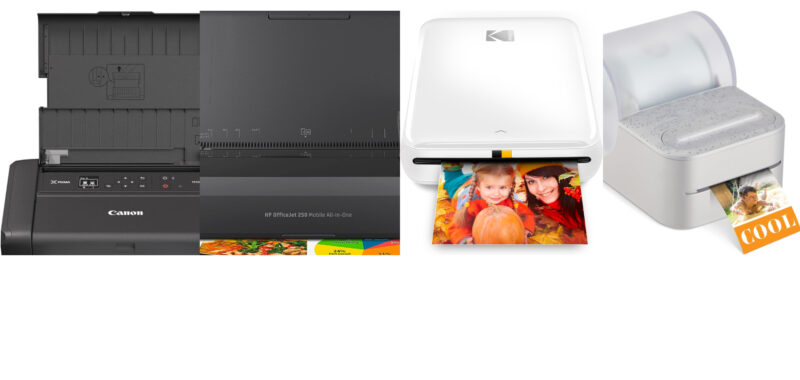We may earn revenue from the products available on this page and participate in affiliate programs. Learn more ›

A portable printer may seem like an anachronism in a world where you can instantly share digital photos and documents around the world in seconds, but there’s still merit in having a physical copy. Sometimes, a legal document requires a physical signature or a less tech-savvy family member needs a picture from your wedding. Inevitably, these requests come at the most inopportune time, either when you’re traveling or don’t have a permanent office in which you can stash a full-sized printer. The best portable printers—like our best overall, the Canon PIXMA TR150—will allow you to accommodate these requests, and many are small enough that you can actually take them on vacation with you if necessary.
How we chose the best portable printers
Our portable printer recommendations are based on a mix of hands-on testing and research. We evaluated printers on their overall size and whether they were designed for mixed-use (printing anything) or a specific use case (printing photos). You’ll have to accept the limitations of portable printers—slower print speeds and limited page size support chief among them—but these downsides are mitigated by how convenient they are to use. Our recommendations support wireless printing (a must-have feature for any printer as far as we’re concerned), and there’s even a model that can print and scan documents and photos.
The best portable printers: Reviews & Recommendations
There’s nothing like the tactile feel of printed photos, whether you need them for work, like playing human photobooth at a party, or just want to share vacation shoots quickly. Prepared to print from locations both near and far? These portable printers cover a wide range of use cases and price points.
Best overall: Canon PIXMA TR150
See It
Specs
- Size: 7.3 x 12.7 x 2.6 inches
- Weight: 4.5 pounds
- Battery power: Yes (Optionally)
- Connectivity: Wi-Fi, USB
Pros
- Full-sized prints
- Can run on battery power
- Durable design
Cons
If you need a fully-featured printer in a compact package, you won’t find a better option than Canon’s PIXMA TR150. The printer, which we’ve tested ourselves, checks all the right boxes: It can run on battery power (a battery is sold separately), create full-sized prints, and is easy to set up and use. Plus, the printer was so small we actually packed it on a long trip abroad, where it survived a trip within a checked bag. While its small screen is less sophisticated than the ones we’re used to on full-sized printers, it was still perfectly serviceable. We could still use the physical buttons next to it to punch in our Wi-Fi password, and the display showed the state of our prints clearly.
When printing documents—both grayscale and color—the TR150 was indistinguishable from any full-sized printer we’ve tried. When printing photos, though, the TR150 struggled to capture the vivid colors from a scene. Plus, it runs on small ink cartridges instead of ink tanks—which is normal for portable printers—so you’ll have to replace them with greater frequency. You’ll need to make this tradeoff when using a “full-sized” portable printer. If this limitation doesn’t bother you, there’s no reason to pass over the Canon TR150.
Best splurge: HP OfficeJet 250
See It
Specs
- Size: 14.96 x 7.8 x 3.6 inches
- Weight: 6.51 pounds
- Battery power: Yes
- Connectivity: Wi-Fi, USB
Pros
- All-in-printer
- Print size legend
- Color touch screen
Cons
- Not as portable as other recommendations
If you can get over its $400 price tag, you won’t find a more feature-complete portable printer than HP’s OfficeJet 250. Setting up the OfficeJet 250 only took a few minutes and didn’t require us to download the HP Smart mobile app, though you have the option to use that software if you’d prefer. Instead, we opted to use the OfficeJet 250’s touchscreen to input our Wi-Fi password and run through any initial calibrations. We experienced no technical hiccups with this printer after its initial setup. It maintained a solid connection to our Wi-Fi network and was always recognized by multiple computers running macOS. The OfficeJet 250 is larger and heavier than our other recommendations, but this is also the only model that can scan and copy in addition to printing.
The OfficeJet 250 printed up to nine pages of text or one full-sized color image per minute in our tests. That’s speedy for a printer that isn’t plugged into a wall and especially impressive given that it creates 8.5 x 11-inch prints just like a traditional all-in-one office printer would. Text looked sharp, and we were especially pleased with the quality of our color print, which was vibrant even on regular printer paper. It may not be called out as a photo printer, but the OfficeJet 250 can be used that way in a pinch—though we recommend having proper photo paper on hand. While we opted to test the printer using 8 x 11.5-inch prints, you can adjust the OfficeJet 250 to accommodate B5, A5, and 4 x 6-inch printer paper.
The photos and documents we scanned looked very good, and only took a few seconds to show up on our computer. You can use HP’s scanning software, but we opted to use the Preview app that comes pre-loaded on MacOS. Our scans weren’t quite at the same level as HP’s premium home printers, but that’s to be expected given its more compact size. The only technical feature we found ourselves missing when using this printer was double-sided printing. Outside of that missing feature, we could happily use the HP OfficeJet 250 as our only printer. If you’ve wanted an all-in-one printer but have limited desk space, travel between a couple of offices, or even want to take a personal printer with you when working abroad, HP’s OfficeJet 250 is worth its high cost.
Best for photos: HP Sprocket Studio Plus

See It
Specs
- Size: 5.45 x 8.5 x 3.9 inches
- Weight: 3 pounds
- Battery power: No
- Connectivity: Wi-Fi
Pros
- Impressive print quality
- Clever compact design
- Fast prints
Cons
We chose HP’s Sprocket Studio Plus as the best portable photo printer and stand by that recommendation here. The Studio Plus’ design feels well thought out, especially its print tray, which sits on top of the printer and then attaches to the front with a satisfying click when you’re ready to print. A trio of LEDs on its front side indicate whether it’s powered on, connected to Wi-Fi, and encountered a problem when printing. All three functions are helpful to see at a glance.
Setting up and managing the printer requires HP’s Sprocket App, which is available on iOS and Android. Once installed, it’ll find and connect your device to the printer over Wi-Fi. You have the option to give the Sprocket app access to your entire photo library or a selection of your favorite shots. Printing on the Sprocket Studio Plus is refreshingly straightforward. You’ll begin by placing the included photo paper inside the printer’s print tray and clicking it in front of the printer’s body. Then, select a photo from the Sprocket app and hit print. The printer will pop out a 4×6 in under a minute.
The Sprocket Studio Plus’ compact size is its biggest strength—It’s easy to take the photo printer to a party and have people send prints to it as mementos, but you will be limited to 4×6 prints. That’s a common size for photos, and the Sprocket Studio Plus is easy to stash in a bag when you go on a trip, but you won’t have the option to print an 8 x 10. That’s not a dealbreaker, and we can still highly recommend picking one up. If it’s photos you’re most interested in printing, this is your best value.
It’s also worth noting that this is a dye sublimation printer and doesn’t use traditional ink, so the prints won’t smudge if you pick them up as soon as they’re done.
Best battery-powered: HP Sprocket Panorama

See It
Specs
- Size: 5.5 x 3.25 x 3.13 inches
- Weight: 1 pound
- Battery power: Yes
- Connectivity: Bluetooth
Pros
- Solid color reproduction
- Wide aspect ratio
- Bluetooth connectivity
Cons
HP’s Sprocket Panorama has most of the features we liked about Studio Plus but in a significantly smaller form factor. Setting up the Sprocket Panorama requires downloading the HP Sprocket app, allowing you to pair the printer with your iOS or Android device over Bluetooth. Bluetooth allows you to print to the battery-powered Sprocket Panorama anywhere, not just when connected to a Wi-Fi network. This feature is one of the main reasons we’ve chosen Sprocket Panorama as the best battery-powered portable printer. The other reason is that you can fit this printer in a small bag—or even a cargo-shorts pocket.
The big tradeoff of choosing an ultra-portable printer is the size of your prints. You’ll end up with a photo that’s just two inches wide, which means you’ll see a lot less detail compared to a larger mains-powered printer. True to its name, you can print a photo that’s nine inches wide. Though our photos were small, we were pleased with how well the Sprocket Panorama’s prints looked, especially the vibrancy of the colors, and there was no denying how cool it looked for it to slowly come out of its front slot. It looked like a tongue beginning to stick out, and slicing the photo with a physical button on top of the printer was also fun. The amount of time it took to create a print depended on its size, but all of our prints took under a minute from start to finish.
If you take a lot of panoramas, this portable printer’s biggest drawback won’t matter much. One feature the Sprocket Panorama shares with the larger Studio Plus is the use of zero ink technology, which means you can handle its prints immediately without the risk of smudging.
Best budget: KODAK Step Wireless Mobile Photo Mini Color Printer

See It
Specs
- Size: 3 x 5 x 1 inches
- Weight: .55 pounds
- Battery power: Yes
- Connectivity: Bluetooth
Pros
- Ultra-portable
- Battery powered
- Bluetooth connectivity
Cons
If you’d like the freedom to print your photos anywhere but don’t want to spend more than $70, Kodak’s Step is the right portable printer for you. The pocket-friendly battery-powered printer connects to your smartphone via Bluetooth using Kodak’s iOS or Android app and can spit out up to 30 2- x 3-inch prints on a single charge. The Step uses the same zero inc technology as HP’s portable printers, which means you can touch your prints immediately without the risk of them getting ruined. Our only complaint with this portable printer is that it needs to be recharged using a MicroUSB cable rather than USB-C. This means you’ll likely need to bring an additional cord with you, which can be a little annoying if you’re taking it on vacation. That doesn’t impact the Kodak Step’s performance, so it can be easily forgiven.
There are many factors to consider when deciding which portable printer is right for you. Below are the factors we considered most important when writing this guide:
Size
The word “portable” is ultimately subjective. Still, our largest recommendation is just over a foot long (this is necessary for making full 8.5- x 11-inch prints), under eight inches deep, and under four inches tall. This is remarkably small for a fully featured all-in-one printer, which can easily be two to three times deeper and taller. Our smaller printer is under five inches deep, three inches wide, and one inch tall, which is practically pocket-friendly.
Weight
If you’re going to be taking your portable printer out of the house, weight is a critical factor to keep in mind when choosing the best one for you. Our heaviest portable printer recommendation clocks in at six and a half pounds, while the lightest is just over half a pound.
Battery power
Some of our portable printers can run off a battery, meaning they’re portable rather than just physically small. This is a neat feature, but you must remember to keep the battery charged for it to work. We’d recommend keeping a power cable around, just in case.
Connectivity options
All of our portable printer recommendations support wireless printing over either Wi-Fi or Bluetooth. Many of the printers above can also be connected to a computer using a USB cable if you’d prefer.
FAQs
Yes. All printers require ink to create prints.
It depends on the printer. Portable photo printers that we recommend use special paper, while the larger general-use portable printers in this guide can use standard paper.
A portable printer is worth it if you don’t have a lot of space in your home office or absolutely have to print when you’re away from your desk.
This depends on its size and feature set. Our recommendations range in price between $400 and $70.
Final thoughts on the best portable printers
Portable printers have come a long way over the years, thanks to the miniaturization of technical components, improvements in battery technology, and the rise of wireless tech accessories. You can easily get a model that suits your printing needs, space requirements, and budget. Portable printers are so good we can even recommend replacing an aging full-sized model with one of our higher-end recommendations for the sake of clearing off a big chunk of your desk.
Why trust us
Popular Science started writing about technology more than 150 years ago. There was no such thing as “gadget writing” when we published our first issue in 1872, but if there was, our mission to demystify the world of innovation for everyday readers means we would have been all over it. Here in the present, PopSci is fully committed to helping readers navigate the increasingly intimidating array of devices on the market right now.
Our writers and editors have combined decades of experience covering and reviewing consumer electronics. We each have our own obsessive specialties—from high-end audio to video games to cameras and beyond—but when we’re reviewing devices outside of our immediate wheelhouses, we do our best to seek out trustworthy voices and opinions to help guide people to the very best recommendations. We know we don’t know everything, but we’re excited to live through the analysis paralysis that internet shopping can spur so readers don’t have to.

